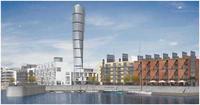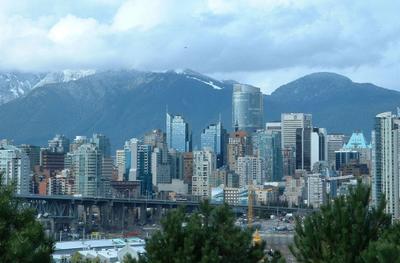
Now lost to the archives of the Internet, I read an editorial on the weekend in the
Toronto Sun that pleaded for the provincial government to build more roads. The Sun is fairly right-wing, but I was still surprised by the vitriol against transit and demands for more highways, "even expressways." Now that I think about it, I've noticed an increasing number of references to
gridlock in the Toronto media of all stripes.
On the one hand, this is a good thing because it is a spinoff of the discussions about the city getting more money and power to shape its physical infrastructure thanks to the long-awaited
gas tax redistributing to local authorities. (Way to get with the 20th century there, guys. ) Any debate about how to spend money on infrastructure is a good debate, since it means people are talking about the built environment of cities.
That said, it will be very interesting to see which way this turns. Here is a breakdown of Toronto's transit personality by decade:
1950s - Small city. Nothing to do and nowhere to go. Streetcar system and city streets are still sufficient.
1960s - Growing ambition. Highway building coexists with subway building as the city remakes itself for the modern era.
1970s - Fear of heights, realization of American planning mistakes, and focus on neighbourhoods. All future highways cancelled. Subways expand slowly.
1980s - Integrated transit system of bus, streetcar and subway is North America's model of efficiency. Ridership peaks. City booms.
1990s - Suburbs pass 50% of regional population and transit (which has not expanded) suffers. Ridership drops, fares go up, toll highways appear in the burbs.
2000s - New focus on transit with some gains. But population shifts have left everyone unhappy and there is no money anymore to build anything, anywhere.
In other words, Toronto is still pretty transit-oriented. Even the road lovers allow that public transit must be supported. But it's like Vienna suddenly grew an Atlanta around it. The downtown is lively, has a huge population and decent transit; but there are also now massive suburbs, office towers outside the core, and industry kicked far into the 'burbs to accommodate all those downtown condos. People must drive because they have no other options. Might be their fault for moving there in the first place but growth was allowed or encouraged and now they are stuck. What to do? An
article today anguished:
Does anybody really believe that better co-ordination of transportation planning, improving communication to drivers, better sequencing of traffic lights and better timing of road construction -- the four big solutions Mr. Tory presented last week -- will make the slightest difference to commuting times? In fact, the present government is already doing most of what Mr. Tory wants to do, and the most one can say is such policies are potentially slowing the rate at which Toronto traffic slows.
Assuming for a moment, that one must do something (more on that later), what is the right path?
1)
Build massive new rapid transit. Hate to say it, but this is pretty impossible. Even if you had billions to spend you can't build enough to suddenly turn a postwar city into Manhattan (and even in Manhattan people hate being forced to take the subway.)
Beijing and
Shanghai are actually trying to do this and it still isn't working for them. The more they build, the more people want to drive. Planners are stunned but infrastructure can't beat the addictive car culture that is now a global phenomenon. Cars are, frankly, amazing if you can afford to have one. They wreck cities but hard to see that from one's insulated little steel cocoon.
2)
Build new highways. The war-cry of conservatives (like that Sun editorial), this just doesn't work. Sorry to call people uneducated, but a careful study of history (and common sense) will show that if you make it easier to drive somewhere, more people will do it, and unless you freeze development you are guaranteeing that new suburbs will clog whatever capacity you build. And it's not exactly insignificant that you have to destroy, as in utterly ruin, whole neighbourhoods to build them. Newsflash --
Robert Moses was spectacularly wrong. It cannot be done.
3)
Change behaviour. Most impossible of all, though it may happen through factors that can't be controlled like the price of oil or federal tax programs. You can try to impose tolls on roads, but good luck finding a politician to support it. The entire structure of our society is geared towards car convenience. Not necessarily a bad thing, as our standards of living have, in many ways, improved as a result. I mean, if all cars were electric would there be any problem at all? (The answer is still yes, but one can dream.)
4)
Optimize. This is the best idea in my opinion. There is actually a lot of space already dedicated to the streets and Toronto has an excellent grid. The problem is that they are often horribly used in terms of efficiency. I'm not talking about fixing a traffic light here or turn lane there. I want total redesign of the streets so that all streets are one-way, all lights are adaptably synchronized and there are minimal screw-ups with cars fighting pedestrians fighting cars for crossings. Encourage transit within this optimization, but don't kick people out of the cars that they were forced, or democratically chose, to drive. Computer technology exists to remake the way we use streets, and Manhattan proved the wonder of the system when it switched from 2-way streets to one-way synchronized years ago. At night you can cruise any avenue in Manhattan for 100 blocks on the "green wave" without hitting a light. No need for an urban expressway - just sail up 8th Ave. Toronto is more complex but much more could be done to keep short-trip drivers off the expressways and on the city streets while not damaging the built fabric that lines them.
This whole crisis is not totally surprising, since the exact same issues have been around before. Check out this
fantastic 1957 CBC television special about Toronto's traffic problems back then. The difference between 1957 and 2007 is the technology. Use it properly and the city street, one of mankind's greatest inventions, may survive just fine for years to come.
 Get ready for a lot of press about Malmo, the formerly industrial city in Sweden that is trying to reinvent itself in a big way. A paradise for urban planners who love to play with waterfronts, they have done a great deal of work in creating an urban oasis in the last few years on what used to be docklands, fill, and a car factory.
Get ready for a lot of press about Malmo, the formerly industrial city in Sweden that is trying to reinvent itself in a big way. A paradise for urban planners who love to play with waterfronts, they have done a great deal of work in creating an urban oasis in the last few years on what used to be docklands, fill, and a car factory.










